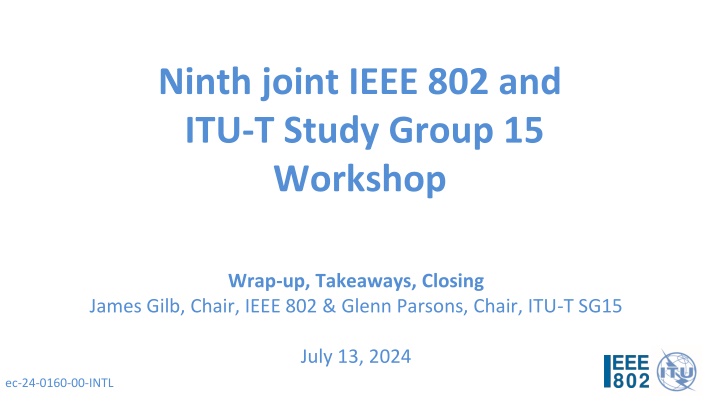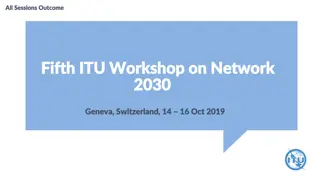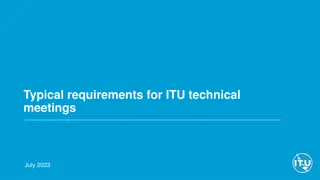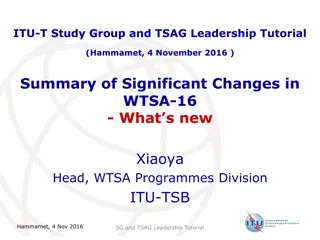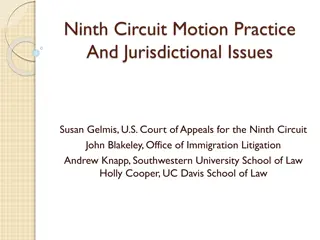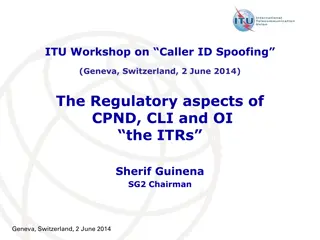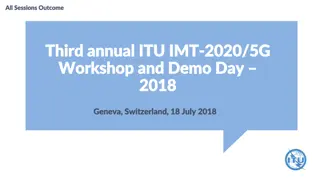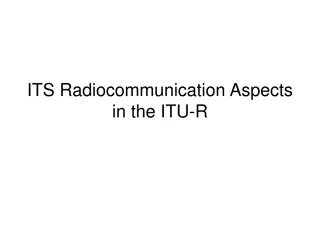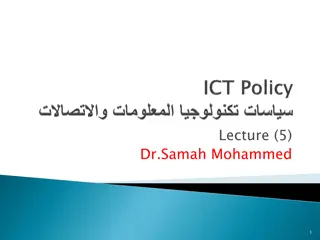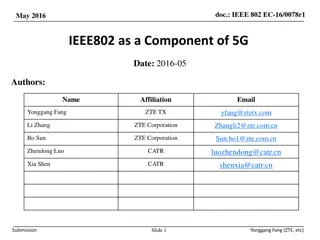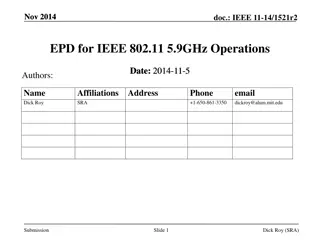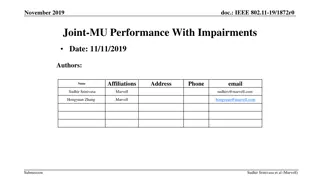Ninth Joint IEEE 802 and ITU-T Workshop Wrap-up and Takeaways
This workshop focused on topics of common interest such as optical interfaces, access networks, synchronization, and data modeling, enhancing collaboration between IEEE 802 and ITU-T. Session highlights included exploration of optical PHYs beyond 800 Gb/s, advancements in access networks, synchronization technologies, and data modeling discussions.
Download Presentation

Please find below an Image/Link to download the presentation.
The content on the website is provided AS IS for your information and personal use only. It may not be sold, licensed, or shared on other websites without obtaining consent from the author.If you encounter any issues during the download, it is possible that the publisher has removed the file from their server.
You are allowed to download the files provided on this website for personal or commercial use, subject to the condition that they are used lawfully. All files are the property of their respective owners.
The content on the website is provided AS IS for your information and personal use only. It may not be sold, licensed, or shared on other websites without obtaining consent from the author.
E N D
Presentation Transcript
Ninth joint IEEE 802 and ITU-T Study Group 15 Workshop Wrap-up, Takeaways, Closing James Gilb , Chair, IEEE 802 & Glenn Parsons , Chair, ITU-T SG15 July 13, 2024 ec-24-0160-00-INTL
Workshop Agenda Opening Remarks James E. Matthews, President, IEEE SA Seizo Onoe, Director, TSB, ITU James Gilb, Chair, IEEE 802 Glenn Parsons, Chair, ITU-T SG15 Session 1: Exploration of Optical PHYs Addressing 800 Gb/s and Beyond Moderators: John D Ambrosia , Futurewei, IEEE P802.3dj Task Force Chair & Steve Gorshe, Microchip, ITU-T Q11/15 Rapporteur Session 2: Access and In-Premises Networks Moderators: George Zimmerman , CME Consulting, IEEE P802.3dg Task Force Chair & Frank Effenberger, Futurewei, ITU-T Q2/15 Rapporteur Session 3: Synchronization and TSN Moderators: J nos Farkas , Ericsson, IEEE 802.1 TSN Task Group Chair & Stefano Ruffini, Calnex, ITU-T Q13/15 Session 4: YANG and Data Modelling Moderators: Scott Mansfield, IEEE 802 YANGsters Chair, ITU-T Q14/15 Rapporteur, Principal Researcher, Ericsson : Session 4 Introduction YANG and Data Modelling Wrap-up, Takeaways, Closing Moderators: James Gilb , Chair, IEEE 802 & Glenn Parsons , Chair, ITU-T SG15
Workshop objectives This workshop focused on topics of common interest such as: Optical interfaces beyond 1T transmission, Access and in-premises networks, Synchronization and time-sensitive networking (TSN), YANG and data modelling. The objectives of this workshop include, but are not limited to, enhancing long-standing collaboration and coordination between IEEE 802 and ITU-T Study Group 15 through discussion and information exchange on topics of common interest.
Session 1: Exploration of Optical PHYs Addressing 800 Gb/s and Beyond Takeaways G.652 Fibre On-going work between ITU-T and IEEE. Liaison from ITU-T to IEEE on recent progress to be considered by IEEE P802.3dj/dk Progress made @ ITU-T Clarity of statistical analysis work made by each group on Chromatic dispersion (CD) PMDQ : ITU-T responded to IEEE query with theoretical analysis on shorter links No further work is planned at this time Observation fibre vendors have been working on aspects other than CD to improve medium >= 800G Coherent Optics On-going communications between ITU-T and IEEE. Liaison from ITU-T to IEEE on recent progress made to be considered by IEEE P802.3dj Observations New TQM approach (alternative to EVM) proposed at most recent ITU-T Meeting Extended TCC Proposal Reference receiver comparable to real world performance Successful examples of the groups in the two organizations working together
Session 2: Access Networks Takeaways Both ITU-T SG15 and IEEE 802.3 have defined optical access networks, and both have produced series of PON systems Overall deployments have exceeded a Billion users Coordination at the physical layer has enabled the reuse of optical components Similarly, both groups have worked on bidirectional optical access physical layers Major application of these are wireless fronthauling The bidirectional access PHYs are essentially equivalent between the two groups Future higher speed systems will be challenging as we approach the physical limits of low-cost technology Time horizon for Very High Speed PON is 2035 a long-term project!
Session 2: In-Premises Networks Takeaways Fiber In-home Networks are being studied in ITU-T Q3 These aim to provide very high-speed distribution inside of homes, businesses, and factories using newly installed fiber cabling Recommendations for P2MP and P2P versions of this have recently been completed Integration with Wi-Fi is essential, because Wi-Fi will be the final link to the users Wi-Fi is subject of a huge body of work in IEEE 802.11 Wi-Fi 6 is currently moving into the market Wi-Fi 7 standardization is nearly complete Wi-Fi 8 will tackle higher reliability Applications are extending beyond simple connectivity: location, sensing, security, privacy Copper PHYs and Powering are evolving in IEEE 802.3 Premises networks are highly variable, and strong tendency to reuse existing wiring There is a huge embedded base of CAT5-6 cable, to be leveraged for many applications Power over these links is a key feature, but it also presents challenges There is a range of new infrastructure applications driving new work on single-pair, lower-speed Ethernet
Session 3: Synchronization & TSN - Takeaways Synchronization continues to be a fundamental function of networks incl. support for connected applications (e.g. Industrial Automation, Data Centers, etc.) Some new applications may place new requirements, e.g., 6G, quantum key distribution Improving synchronization resiliency and security is essential Synchronization standards evolve to address these new requirements and use cases, incl.: IEEE 1588 ITU-T SG15/Q13 802.1AS Evolution of transport technologies and the Ethernet PHY should enable the distribution of accurate timing Transfer to inclusive terminology
Session 4: YANG and Data Modelling Takeaways YANG and NETCONF have broad acceptance in the standards community YANG and NETCONF are being enhanced and community feedback and support is encouraged Tooling to support development, validation, and maintenance are constantly evolving Industrial Applications are driving development of profiles
